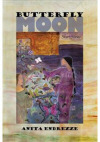Butterfly Moon
The short stories by Anita Endrezze in Butterfly Moon are a hybrid of myths and folklore, mostly with a contemporary setting. Many traditions—Native American, Norse, Greek, Romanian, Transylvanian—are used with appearances by guardian angels, gypsies, witches, familiars, shadows, a vampire, the three fates—and a Jungian therapist. The breadth of her reach is not surprising as her father is a Yaqui Indian with roots in Sonora, Mexico and her mother’s roots are in Slovenia, Germany, Romania and Italy. For all the elements combined, the stories run smoothly as they take place in psychological space where we want answers about ourselves in the world. With the prominence of interior space, the drama is within the personal field of the characters . . . and in this personal field of hopes and desire for mercy, human beings haven’t changed much over the millennia.
The short stories by Anita Endrezze in Butterfly Moon are a hybrid of myths and folklore, mostly with a contemporary setting. Many traditions—Native American, Norse, Greek, Romanian, Transylvanian—are used with appearances by guardian angels, gypsies, witches, familiars, shadows, a vampire, the three fates—and a Jungian therapist. The breadth of her reach is not surprising as her father is a Yaqui Indian with roots in Sonora, Mexico and her mother’s roots are in Slovenia, Germany, Romania and Italy. For all the elements combined, the stories run smoothly as they take place in psychological space where we want answers about ourselves in the world. With the prominence of interior space, the drama is within the personal field of the characters . . . and in this personal field of hopes and desire for mercy, human beings haven’t changed much over the millennia.
Through storytelling, using material from many cultures, we see what a rich collective heritage we have in terms of literary structures to express our experience. We see also how our modern attention has shifted. In the mythic way of seeing, there is the archaic layer of our anthropomorphizing nature and the earth that we have lost in our Western culture of commerce and science as we strain the limits of the earth’s balance. Nature has its-own-life-to-itself for which we were once more attuned, held reverence and enlivened by: “The house was a forest remembering itself. The pine trees that held up the walls dreamed of stars dwelling in their needles. Jointed, branched, rooted, the trees still listened to the wind.”
In this reverence and attunement to nature’s aliveness, we had envisioned, in those early times, intercessory figures of angels and witches we made supplication and bargained with in order to get help with unpredictable forces:
I am a being from the Other Side, as you call it . . . .I stand by the Temple of Reedy Rivers, its doors made of shifting sand and yellow canaries. There are many doors; I am one of them. My eyes can be as glittery as dragonfly wings. Or they can be as piercing as a cop’s.
Myths provided a framework for the psyche to cope with life’s breakage. In “Constellation of Angels,” a child lost in a miscarriage because of the father’s alcoholism and his physical abuse of the mother was left too deformed to live. The child is cared for by the angels:
Mary . . . could see ashen-faced spirits reaching out their transparent hands, their black palms pulling out the dead fetus and unraveling the cord of life. The baby rose up and looked down on her mother.
She smiled, now beautiful and whole.
Myths and folktales, as with Endrezze’s stories, deal with psychic fears of the most ultimate kind. In “Owl Woman,” Belle, a twelve-year-old girl, doesn’t know if her mother killed her father when they were fighting: “If she killed him, then the police would’ve taken her to jail. But she’s still here, so he can’t be dead. Yet he’s not here. Mama says he doesn’t care about me, but I know that’s not true.”
The characters’ explanations humanize difficult, often overwhelming, events happening to them by using their hopes, wishes, dreams. In this land between the real and our attempts to construct words about our place in reality, we often have no firm place to stand. In “The Snow Queen,” Joy says to her therapist: “It’s the enchantment. The spell must be broken, or I will never return.” But—“the spell” was what was keeping her in this tangible world away from her wishes . . .
Although the stories are in flesh and blood, tangible reality, whether in the sixteenth century or now, the characters are encased in the author’s omniscient wisdom space of telling, not showing. This sense of “generic characters,” even as they are in a real life setting, stands out because of our modern sensibility that the individual may be alienated, ill, suffering a tragedy, but it is “the individual character” who handles the problem and the author also awaits for the character to speak. Readers will make their own decision whether this kind of omniscient retelling of myths and folklore works for them. One thing is certain, these stories let us see clearly how the dominant materialistic culture has lost the reflex that all of life is connected and how our individual life has a dimension that is not just of a disconnected time and place: we belong to the past and the future. Endrezze reminds us that humanity is a collective enterprise. In “White Butterflies,” an Indian child in 1530, whose village is decimated by smallpox brought by the Conquistadores, captures the vulnerability that animates the space of myth: “Everyone was sick and I was too young. I didn’t know enough. I tried to heal them with my hands, but my blood felt like corn popping in the fire.”





